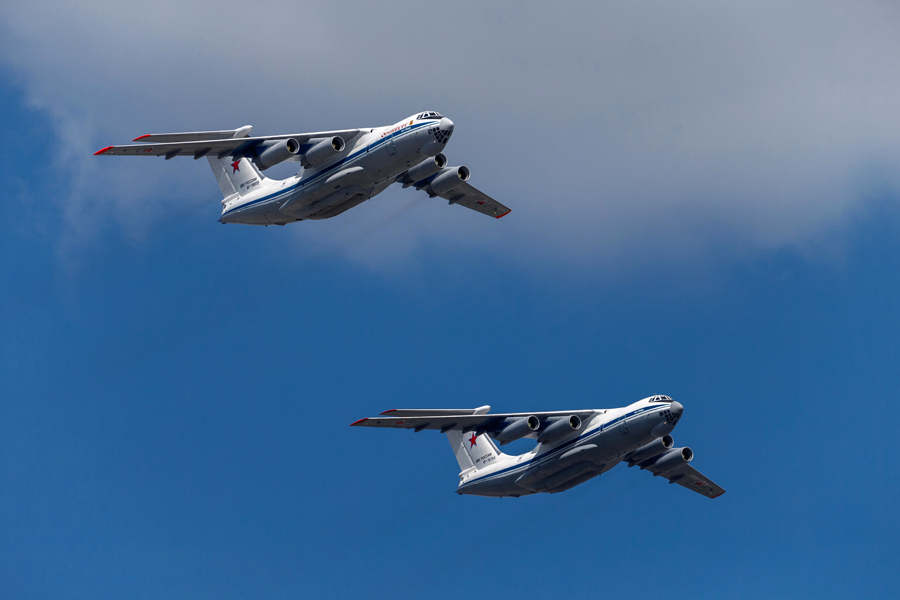
This is not the first time that Russia has tried to develop an effective plane-mounted laser weapon, and reflects the resurrection of an old project begun in the Soviet era.
Mil.ruRussia is working on a plane equipped with a new-generation laser, a source in the Russian defense industry has said in an interview with the TASS news agency. "The defense industry is working on a new-generation air-based laser," said the source.
In his words, the plane with the laser is being referred to as the A-60. Earlier, the mass media reported (in Russian) that the weapon is being realized as part of the Sokol-Eshelon project.
However, this is not the first time that Russia has tried to develop an effective plane-mounted laser weapon, and reflects the resurrection of an old project begun in the Soviet era.
Work on the air-based laser system (LKAB) began in the Almaz scientific-productive association in June 1965.
Almaz carried out the work on the aviation system along with the G. M. Beriev aviation scientific-technical plant in Taganrog (700 miles south of Moscow).
Together the two scientific centers created the A-60 Soviet aviation laser system, to be installed on the Il-76 airplane. Active testing of the flying laser system was conducted at an airport near Moscow in 1983. On April 27, 1984 the A-60's laser successfully struck an aerial target, which received the necessary damage after being hit with the radiation.
In the 1990s, due to the collapse of the USSR and the consequent economic crisis, work on the project was halted. It was renewed only in the 2000s.
Experts say that it is incorrect to attribute to the laser system "the objective to intercept combat blocks of ballistic missiles." "No one ever expected this of the LKAB," said Konstantin Makienko, deputy director of the Moscow-based Center for Strategy and Technology Analysis.
Specialists have distinguished not so much the possibilities of striking the target thermally as the laser’s potential to suppress optic-electronic reconnaissance instruments: periscopes, rangefinders and other devices that modern weapons possess. Thanks to their focus characteristics, such devices significantly augment the impact of laser radiation. The laser's striking range can be hundreds and thousands of times greater in comparison to the limited range of the thermal strike, say Almaz representatives.
 The A-60 Soviet aviation laser system was to be installed on the Il-76 airplane. Source: Krasnaya zvezda
The A-60 Soviet aviation laser system was to be installed on the Il-76 airplane. Source: Krasnaya zvezda
Laser weapons are attractive primarily because of their possibility to unexpectedly and practically instantaneously (with the speed of light) attack the enemy. They are also interesting because of the inexpensiveness of the “shot,” their high precision, as well as the absence of the need to maintain an arsenal of "ammunition" during peacetime. Because it can be installed on a plane a laser can be used in all weather (shooting is not affected by cloudiness, for example), it can be transported to various locations and it can be easily maneuvered.
In August 2009 the defense industry carried out an experiment in which the laser ray from the A-60 plane was aimed at a spacecraft at an altitude of over 900 miles (1,500 kilometers). Several dozen space apparatuses were discovered and tracked by the laser during the flight. At the end of 2012, according to the Izvestiya newspaper, the Defense Ministry ordered the renewal of work to create combat lasers that would strike airplanes, satellites and ballistic missiles.
The U.S. also carried out tests of a powerful laser as part of the ABL project aimed at creating an anti-missile defense system. Boeing, Northrop Grumman and Lockheed Martin participated in the project. In land tests conducted in 1985, the chemical laser heated up and blew up an immobile fuel tank at a distance of around 1,000 yards (about 1 kilometer).
This system had been assembled on the modified Boeing 747-400F cargo plane. The ABL consisted of infrared sensors for identifying the targets, three lasers and a lens system for focusing the ray. The tests were carried out almost annually, but in the end the testers were not able to reach the desired level of effectiveness. The project was abandoned in 2012.
"The domestic aviation laser complex will use the excellence of laser weapons to maximum effect for solving important problems in Russia's aerospace defense. We are convinced that, by creating this innovative system, Almaz and the association of enterprises will maintain their leading position in the development of laser systems," said a spokesperson from the Almaz press service.
First published in Russian by Gazeta.ru
All rights reserved by Rossiyskaya Gazeta.
Subscribe
to our newsletter!
Get the week's best stories straight to your inbox